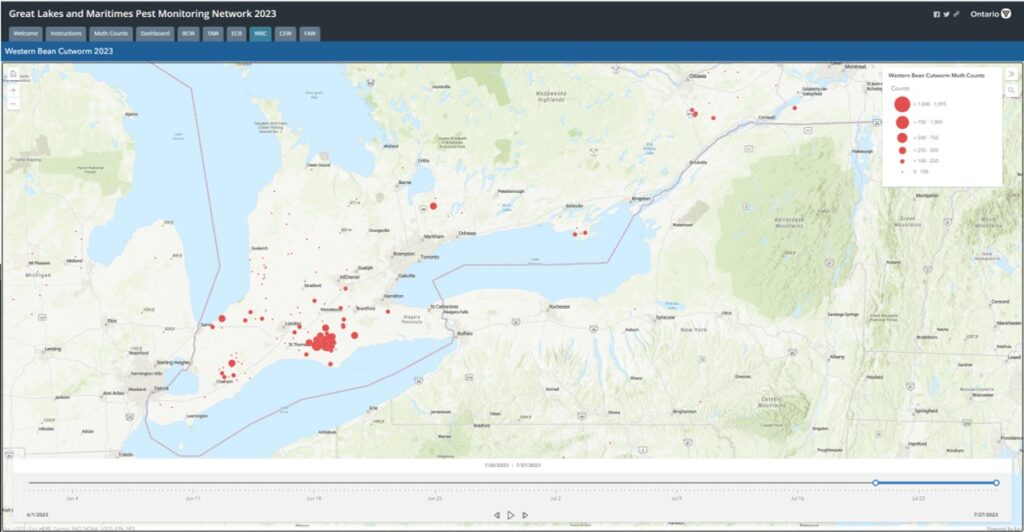Western bean cutworm (WBC) activity is trending higher this year than the previous three and could reach levels more similar to what we saw in 2018. WBC moth trap catches jumped this week by the 100s, with a few locations in Norfolk and east Elgin jumping into the 500 – 1000 moths per trap range. We are finding eggs and newly hatched larvae too but have not reached peak moth flight yet. Peak is likely to happen either next week or in two weeks time.


Scouting early planted corn fields first is recommended. Especially those entering or in VT stage. There are lot of fields with silk emerging but no emerging tassel yet. Younger fields will more likely be targeted by moths after peak flight, as well as dry bean fields. Moths lay their eggs on the upper surface of the leaves in corn. In the past, they would focus on the top two or three leaves near the tassel but now we can find eggs on any of the leaves between the ears and tassels. White eggs are freshly laid, tan are about 2 to 3 days old and purple are at least 4 to 6 days old and about to hatch. Scout 100 plants (10 plants in 10 areas of the field) two or three times within a two to three week period. If 5% of the plants scouted across the two or three scouting events have egg masses on them, a spray is recommended. Target the application to when the majority of the egg masses are about to or recently hatched.

What does this mean for spray timing? Those applying fungicides this week who added insecticides might have been a little too early for WBC control. There’s more egg laying to come. Peak flight (with peak egg laying shortly after) is expected in a week or two. Add another 5 to 7 days for those eggs to hatch. So if an insecticide product provides a maximum of 2 weeks residual, spraying this week or earlier would mean the insecticide residual would be gone by the time most of the eggs have hatched. Spraying next week or the week after would have insecticide residual still present when eggs hatch. As long as the crop is still at R1 or R2, this still lands within the ideal window to be able to tank mix fungicides to target for ear moulds. This year might be especially important to ear mould protection, given the weather conditions and the added WBC activity.
As for dry beans, insecticide applications now would also be too early. Target spray timing for approximately two to three weeks (10 to 20 days after peak) from now.
A reminder that lambda-cyhalothrin products are not available for use on field crops this year. That removes both Matador and Voliam Xpress as options to use. Dry beans are left with only Coragen to use, eliminating the ability to rotate product chemistries to reduce the risk of resistance. In corn, make sure to use a product you didn’t use last year, to reduce the risk of resistance. To find out what products are registered for WBC, refer to the Crop Protection Hub’s WBC pages.
Crop Protection Hub – WBC insecticides on Corn
Crop Protection Hub – WBC insecticides on Dry Beans
Follow the WBC trap map on the Great Lakes and Maritimes Pest Monitoring Network to see what the activity is like in your region over the next few weeks.
One thought on “Western Bean Cutworm – Scouting and Management Timing Important this Year”
Comments are closed.